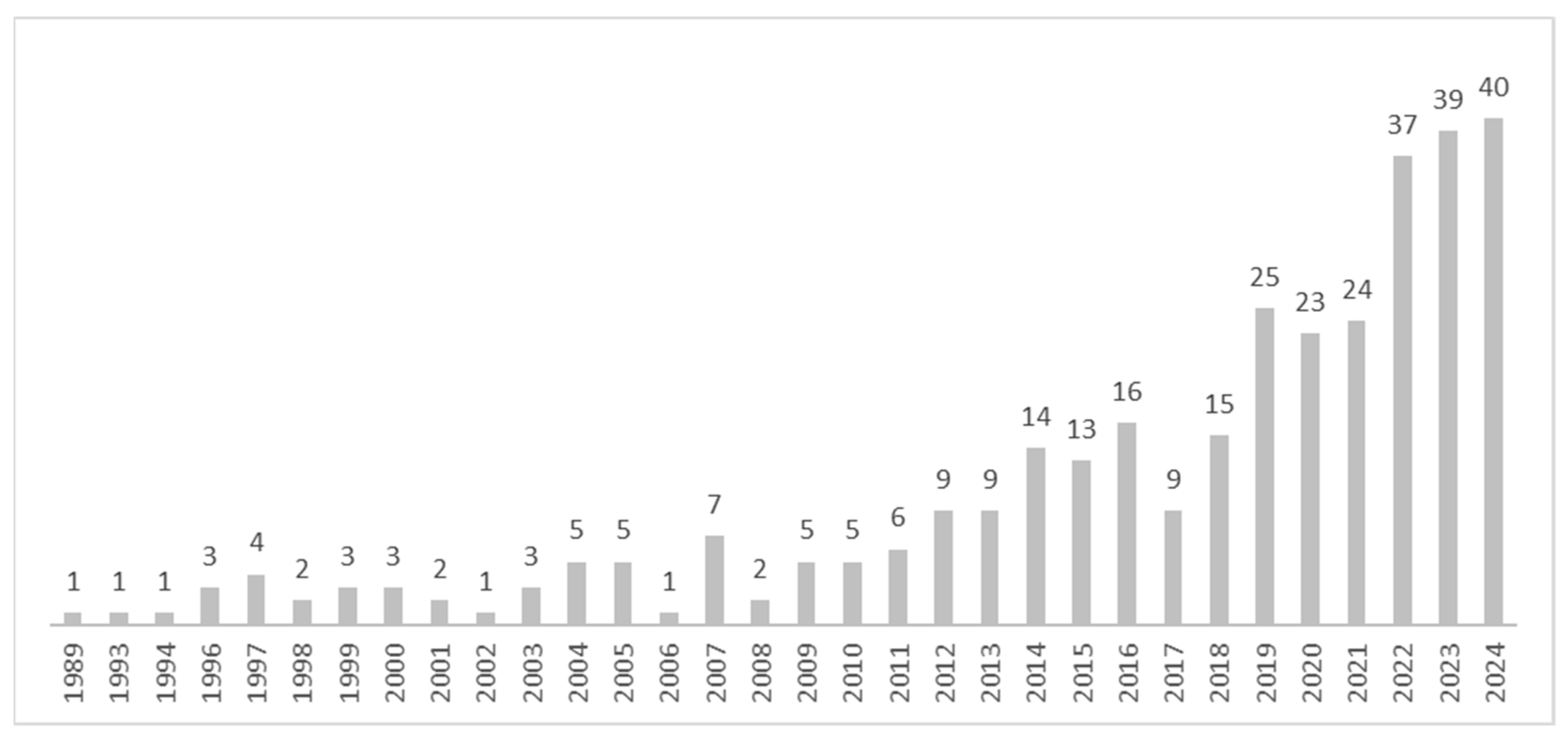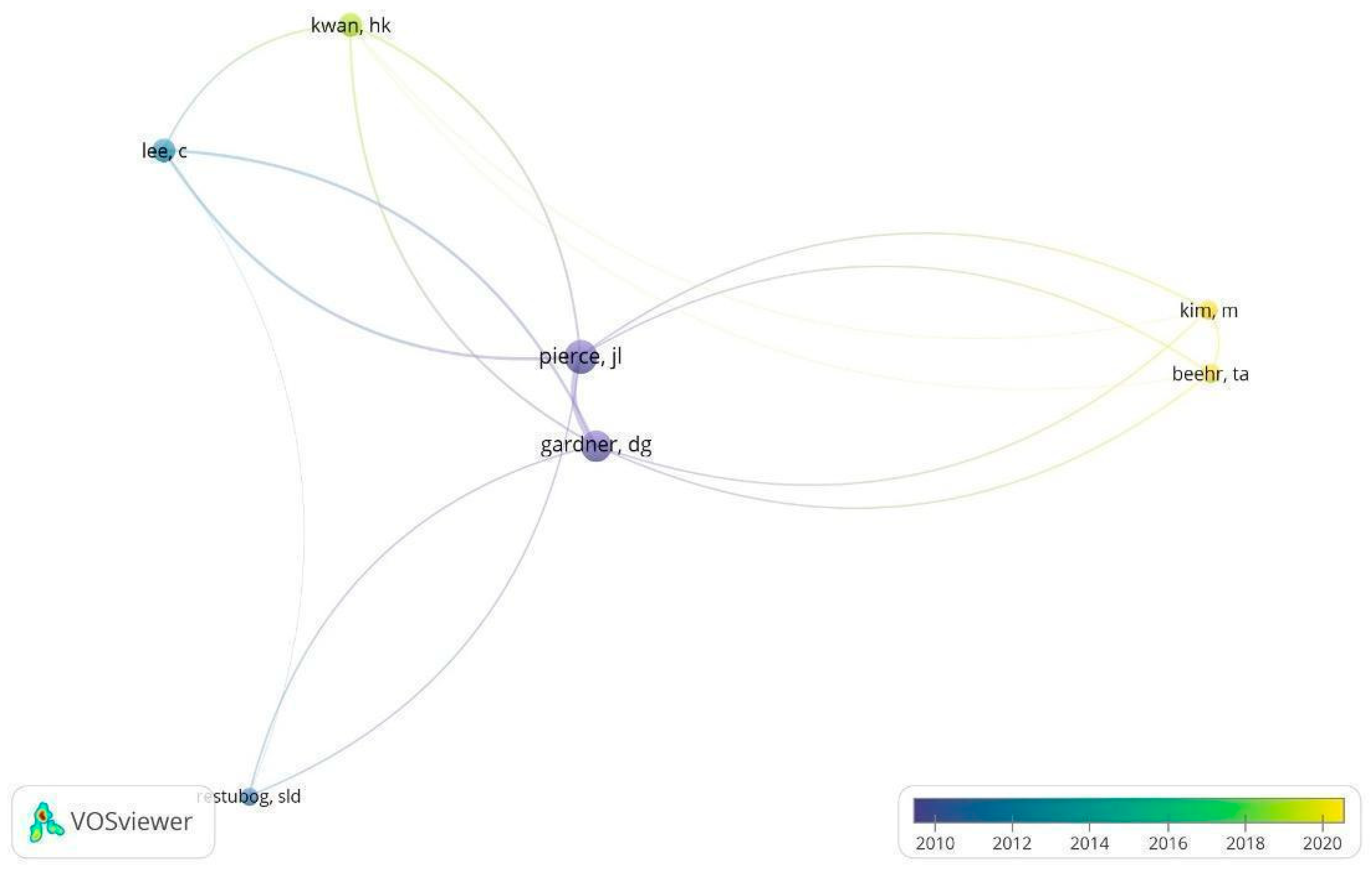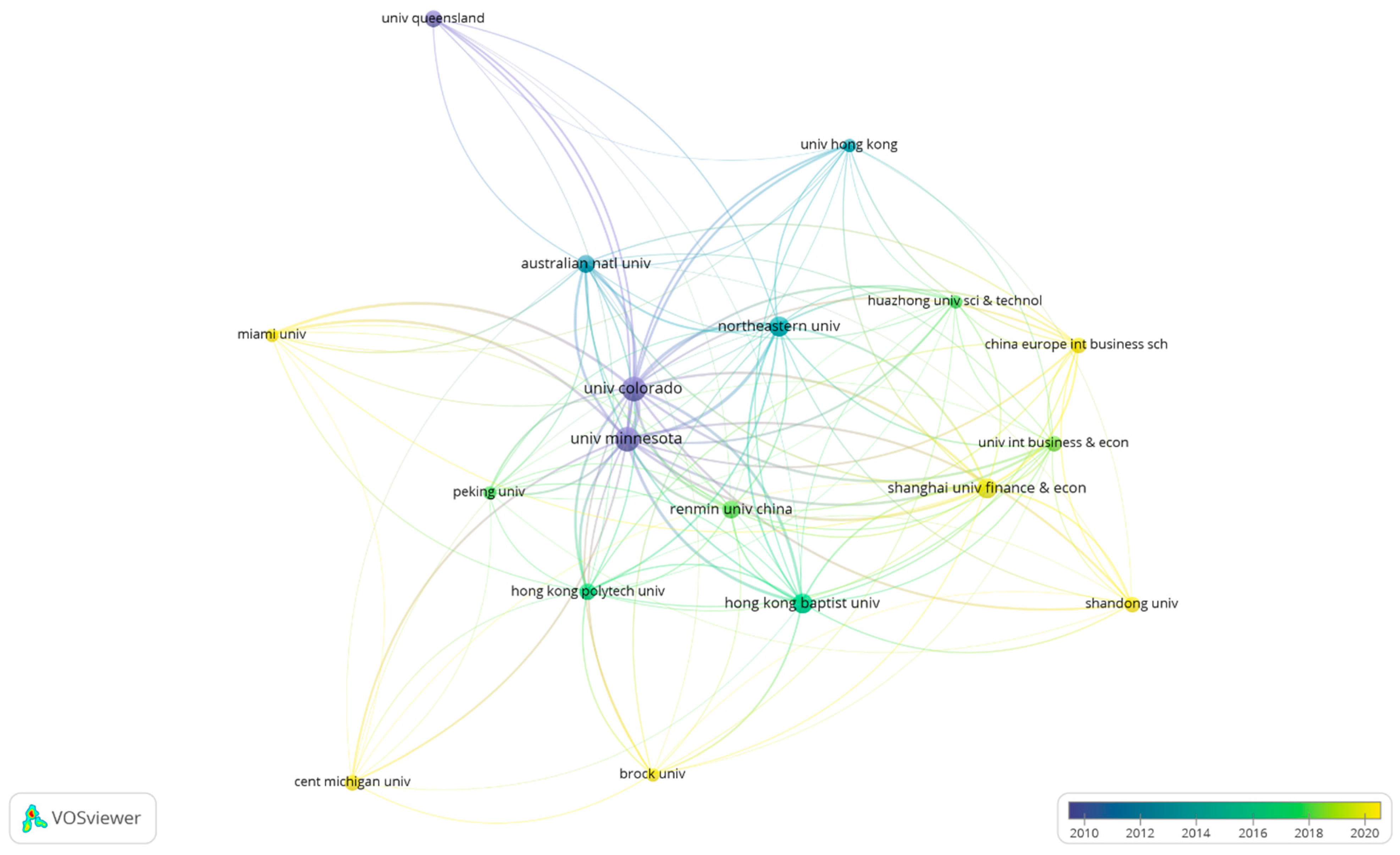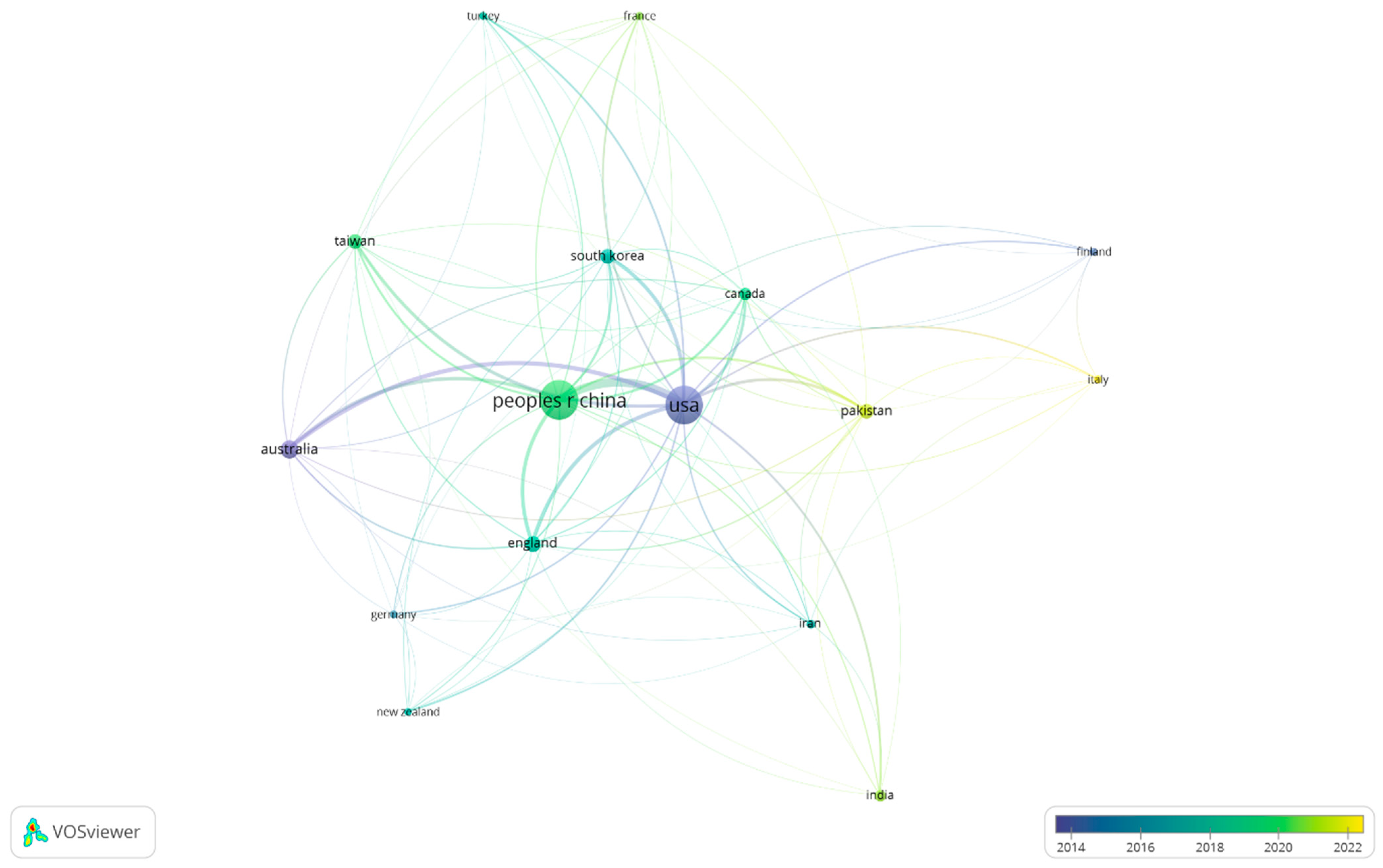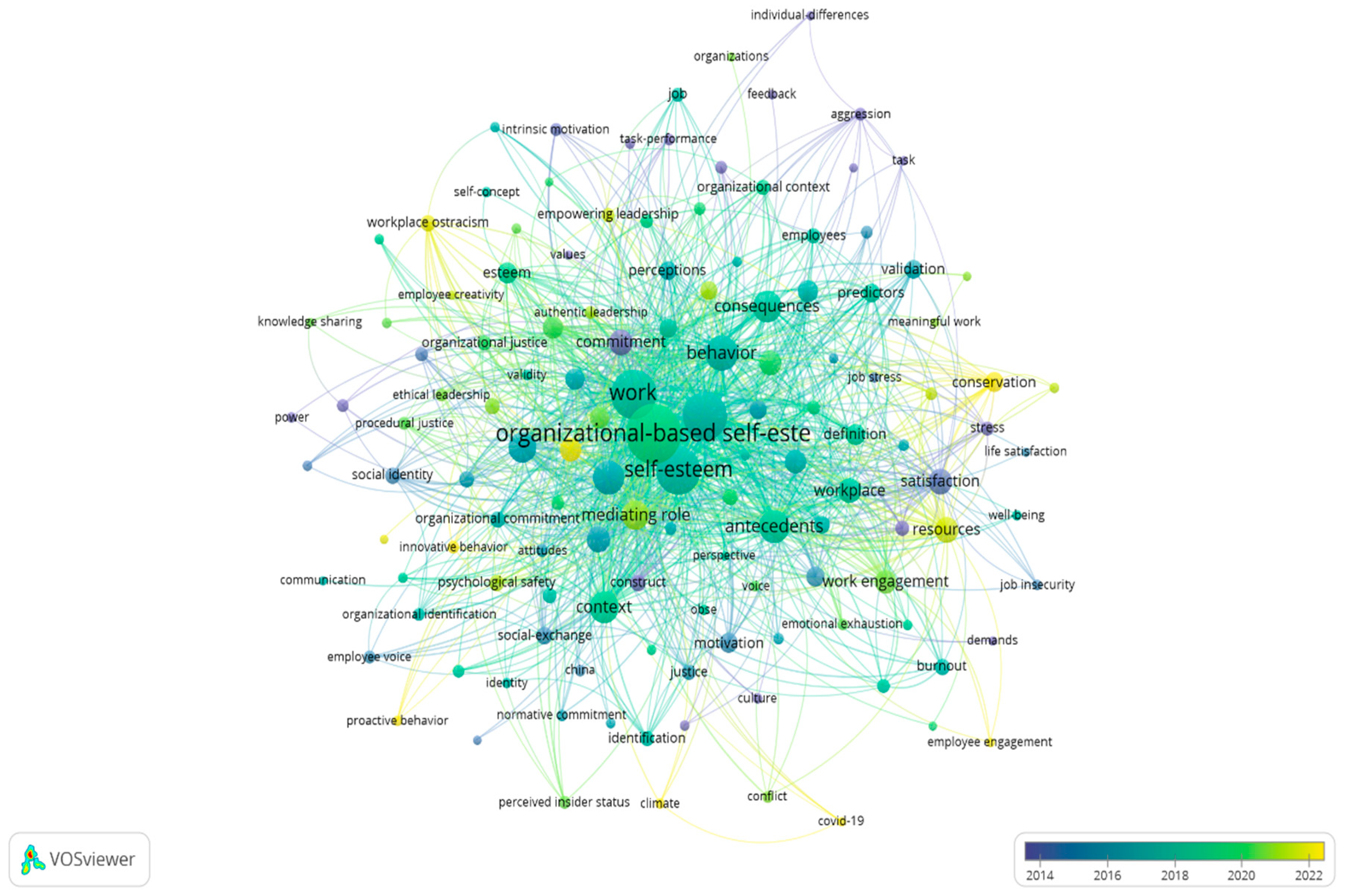4.1. Authors’ Landscape
The illustration in
Figure 2 displays authors who published at least five papers on OBSE; this is also displayed in
Table 1.
“Pierce, Jl” and “Gardner, DG” published the highest number of documents on OBSE. In the citation map, they are in fact centrally positioned and linked to all the other researchers. They published the very first paper on OBSE [
7] in which they coined the definition and elaborated the scale for this construct. Throughout their careers, they have explored a diverse set of OBSE-related topics, such as the effects of pay levels on OBSE [
9], the relationship between OBSE and personality [
39], OBSE as a team phenomenon [
40], and OBSE in relation to effective organizational socialization [
26]. Focusing on the rest of the map, we can identify two additional clusters. The first one is formed by “Kwan, HK” and “Lee, C”. They researched a variety of topics, including a joint study on the detrimental effects of workplace ostracism [
41] or the effects of job insecurity [
42]. The second cluster instead is formed by “Kim, M” and “Beehr, TA”. The closeness between these authors reflects their active engagement in similar research topics: they studied the effects of environmental resources on employees’ crafting behaviors through organization-based self-esteem [
43], the positive effects of empowering leadership on OBSE and meaningful work [
44], and the positive effect of challenge stressors on OBSE, which is in turn positively related to perceptions of meaningful work [
45]. Lastly, “Restubog, SLD” is in a peripheral position in the network, although they worked on popular topics in OBSE research. For example, they published on leadership [
46,
47], promotability [
48], and work-group mistreatment and inclusion [
49,
50], with inclusion being a key concern of SHRM [
51].
This analysis identifies the significant contributors to the field, based on the number of papers. Although their production is diverse and covers a wide timespan, none of them produced papers directly related to SHRM nor on the wider topic of corporate sustainability. However, topics such as inclusion at the core of SHRM were discussed.
4.2. Main Publishing Organizations
To further investigate the network structure of the literature on OBSE, a performance analysis of universities was performed.
Figure 3 shows a citation map of organizations that published at least five documents; in total, the map displays 18 universities (as listed in
Table 2).
The main institutions (University of Minnesota and University of Colorado System) are those where the main researchers were active—as shown in
Figure 3, these entities are centrally positioned in the network, linked to all other institutions, and associated with the highest number of publications. These universities mostly cover the production of the two main researchers identified above. Out of the remaining universities, the Hong Kong Baptist university shows a diverse production, with most papers focused on leadership styles: for instance, research there investigates the detrimental effects of abusive supervision [
52]; the consequences of authoritarian leadership [
53] on OBSE and work outcomes; and the positive effects of empowering leadership for work and family outcomes [
54]. The Northeastern University also displays a diverse production, with the most cited studies focusing on the detrimental effects (on OBSE) of workplace ostracism [
41], on the influence of OBSE on the relationship between perceived organization support and its work outcomes [
55], and on the effect of leadership on OBSE [
56]. We note that universities associated with a recent production are located toward the borders of the network, indicating that they have not yet acquired a central influence, consistent with the recent production year. Among these, we focus on studies produced in the Miami University, where a single author focuses on leadership as well as inclusion matters (see for instance [
57]). Overall, the analysis of leading universities publishing on OBSE extends the focus from being solely on the authors. Also, in this case, there is no study openly addressing SHRM nor corporate sustainability concerns. However, we note the contribution of the Miami University, whose studies on inclusion extend the literature on organizational diversity, thereby touching themes which are at the core of the social dimension of SHRM.
4.4. Keywords Analysis
The keyword co-occurrence analysis facilitates a visual representation of research themes and their temporal evolution. In constructing the network, a Thesaurus file was used to consolidate semantically equivalent keywords that would differ in spelling (e.g., Organization-Based Self-Esteem and Organisation-Based Self-Esteem) or due to the use of plurals or singular forms (e.g., behavior and behaviors). This process resulted in a network map comprising 132 nodes (
Figure 5).
To analyze the evolution of keywords, the network’s nodes were divided into three clusters, notably theoretical frameworks, consequences, and antecedents of OBSE.
Table 4 shows the top keywords related to theoretical frameworks, based on the occurrence frequency.
At the inception of literature on OBSE, the Social Exchange Theory appeared to be a popular framework: this theory explains the formation and maintenance of interpersonal relationships in terms of the reciprocation of valued resources between two interacting individuals [
72]. This theory was used, for instance, to determine the relationship between OBSE and burnout [
73].
Moving from the Social Exchange Theory, the Leader–Member Exchange (LMX) became popular shortly after. High-quality Leader–Member Exchange has been shown to positively influence OBSE and drive subsequent outcomes. For instance, LMX can contribute to work effort via OBSE [
74] as well as to organizations’ sustainable development [
75]. Chronologically, the Job Demand Resources (JD-R) model [
76] appears to be popular, on average, in conjunction with LMX. This model explains the stress outcome as an imbalance between job demands and job resources. The highest number of occurrences is associated with the keyword “Resources”, which can refer to both “Conservation of Resources” (COR) theory, as well as to JD-R, which are the theories investigated in the most recent times. In the context of COR, OBSE is mostly presented as an individual resource that can minimize the effect of adverse phenomena depleting individuals of their other resources.
Generally, we note that theoretical frameworks used in more recent times (such as the Conservation of Resources Theory) are not connected to the topics which were common at the inception of OBSE literature (e.g., trust, power, feedback, values, culture, role conflict, aggression) which may preserve research potential. For instance, “trust” has been shown to be a key component of SHRM practices: the literature shows that this HR approach enhances organizational trust and fosters performance [
6]. Therefore, we expect this scholarly field to gain from re-exploring topics which were popular at the beginning of the OBSE literature through the lenses of more recently employed theoretical frameworks. On the other hand, the Social Exchange Theory could be revisited and connected to SHRM practices: both approaches are based on mutual benefits and are oriented toward creating lasting relationships, in which employees can experience and deliver long-term, added value. Additionally, according to the Social Exchange Theory, sustainable HR practices could the foundation of a social exchange which is perceived as fair for both employees and employers. The literature could also be expanded by linking this theory with other topics that are popular in modern OBSE literature to explore whether, according to Social Exchange Theory, high-OBSE employees would feel compelled to reciprocate SHRM via sustainability oriented behaviors and initiatives.
Overall, the terms which can be identified as consequences of OBSE are well connected with nodes across the full timeframe displayed, as is also proved by most of the average publication years shown in
Table 5, which fall in the middle of the timeline. The literature initially investigated commitment and satisfaction in relation to OBSE, and proved that OBSE is an antecedent of affective commitment to organizations and supervisors [
77] and of job satisfaction [
78]. In more recent times, performance [
70] was also shown to be a consequence of OBSE as well as Organizational Citizenship Behavior [
79]. Recently, the literature has started to focus on work engagement [
80], showing that attributions of substantive Corporate Social Responsibility (CSR) are positively related to work engagement via work meaningfulness, psychological safety, and organization-based self-esteem. Similarly, OBSE and work engagement mediate the positive relationship between CSR perceptions and extra or in-role safety behaviors [
81]. We note that the literature on OBSE’s consequences evolved to incorporate, especially in recent times, studies focused on corporate sustainability, and more specifically CSR. However, except for the aforementioned papers, the analysis of OBSE consequences is not sufficiently rich in words related to SHRM nor to the wider theme of corporate sustainability. As a remediation, we suggest a further investigation of the relationship between SHRM, OBSE, and specific types of employees’ experiences; we suggest focusing on voice behaviors, creativity, and meaningful work. These terms gained increased popularity in modern times and can enrich the literature on OBSE consequences with matters of contemporary interest. Voice behavior is defined as the discretionary or formal expression of ideas, opinions, suggestions, or alternative approaches directed to a specific target inside or outside an organization with the intent to change an objectionable situation and to improve the current functioning of the organization, group, or individual [
82]. Recently, a new type of voice behavior has earned increased scholarly attention, i.e., green voice behavior, defined [
83] as the act of making innovative suggestions for environmentally friendly practices, and advocating for changes that promote sustainability within organizations. The correlation between OBSE and this type of voice behavior could be examined in the context of SHRM to determine whether voice behavior would be encouraged by such practices. Future research may also examine the relationship between OBSE and other prosocial behaviors, redefined in terms of their green or sustainable aspects.
Creativity is another consequence of OBSE [
84], which has recently started to gather scholarly attention. Future studies could investigate how SHRM impacts creativity in a sustainable direction, considering the triple bottom line definition of sustainability [
15]. The existing literature already shows that green human resource management promotes green creativity [
85], including the mediating role of self-efficacy [
86]. The future literature may expand such line of research by including the mediating role of OBSE in the paradigm, and determining if SHRM practices, having a broader focus compared to green human resource management practices, contribute to creativity in a wider sense.
As shown in
Table 6, the earliest, highly occurring antecedent of OBSE is personality. Different authors rely on different definitions of “personality”. For instance, research found that proactivity leads to job performance and organizational citizenship behavior via the mediating role of OBSE [
87]. A further study instead focuses on narcissism as a personality trait that can moderate the relationship between being recognized as a talent and OSBE [
88]. Maintaining the focus on individual factors, the literature also focused on self-esteem as an antecedent of OBSE: self-esteem is defined as the attitude of approval (or disapproval) that an individual holds towards themselves [
89]. Research proposed that self-esteem could be conceptualized as a hierarchical structure, suggesting that individuals may have different perceptions of their worth and competence in various roles [
90]. Starting from the higher-order construct of global self-esteem, OBSE refers to one’s belief about their self-worth and competence as an organizational member [
7]. In other words, OBSE is a domain specific form of global self-esteem, and the two (OBSE and GSE) should be understood as two different but related constructs. The recent literature studied the relationship between global self-esteem and OBSE, and found that the two are positively correlated. However, OBSE and GSE trajectories differently predict changes in job satisfaction, commitment, work engagement, and burnout [
58].
The remaining, highly occurring, antecedents of OBSE are linked to leadership. Considering leadership as an antecedent of OBSE, the literature shows consistent findings. For instance, transformational leadership increases OBSE [
91]. We also note a contribution that shows that not only may transformational leadership increase work-specific self-esteem, but that it may also lead to increased inclusion [
92], with inclusion being a key concern of sustainable human resource management. Except for this study related to inclusion, the analysis of keywords related to antecedents of OBSE does not appear sufficiently rich in themes related to SHRM (nor to the wider theme of corporate sustainability).
Generally, for the antecedents of OBSE, we note a tendency that characterizes the full keyword map: there are well-connected nodes with a similar average publication year, appearing in green towards the center of the map. Keywords related to recent timeframes (nodes in yellow) or to the inception of literature on OBSE (nodes in purple) appear towards the borders of the map, indicating that they are not fully integrated in the literature. The literature on OBSE can be expanded, incorporating modern keywords such as meaningful work. Meaningful work is defined as the degree to which employees view their work as significant [
93]. Meaningful work is jointly examined with OBSE and the effects of different types of leadership on employees’ response [
44,
47,
93,
94]. Meaningful work has also been proved to guarantee organizational sustainability by encouraging employees to stay [
95]. The literature on meaningful work and OBSE appears limited and can be expanded by linking meaningful work with SHRM practices, ensuring that OBSE is employed as a mediator in these models.
Investigating the role of culture in relation to OBSE was more popular at the inception of the literature production, but this area could benefit from additional research as organizations have become increasingly global and hence multicultural over the past decades. Hofstede [
96] describes culture as a system of shared values. The previous literature [
97] confirms that cross-cultural differences can profoundly affect motivations, cognitions, emotions, and behaviors. In other words, culture as a contextual factor can influence the way employees respond to work-related stimuli, including HR practices. For instance, Ref. [
98] show that different cultural traits determine how individuals respond to SHRM practices and hence influence the outcomes of such practices. Similarly, research [
79] proved that OBSE has different outcomes depending on the culture of the population of reference (in the study at hand, this may depend on the importance culturally attributed to work). The literature on OBSE goes beyond the definition of culture as a national or social factor, and integrates the importance of organizational culture [
99], showing that when a company’s values closely match the values of the local society, employees are more likely to have positive attitudes and behaviors because of their shared values. However, the study warns that changing a company’s own established culture to match the local culture can be a mistake, especially if it means giving up values that have made the company successful. This introduces an additional layer of analysis, which is the company culture, defined as “collective programming of the mind that distinguishes the members of one organization from others” [
100]. In summary, previous work about culture underscores the importance of this contextual element on a national and organizational level for both SHRM and OBSE; however, to date, the literature has not fully integrated these perspectives.
Overall, such research directions are expected to expand the OBSE literature in tandem with corporate sustainability and SHRM. To date, there has been no mention of OBSE in direct relation with these themes, except for a limited number of papers produced in the last decade.
